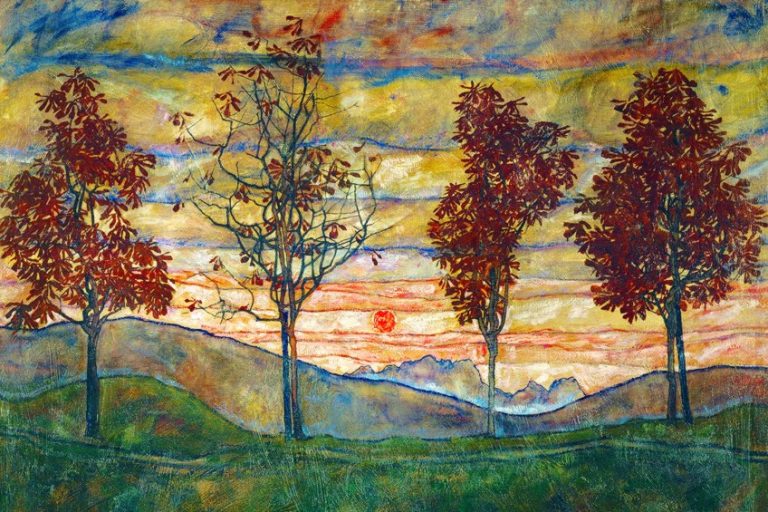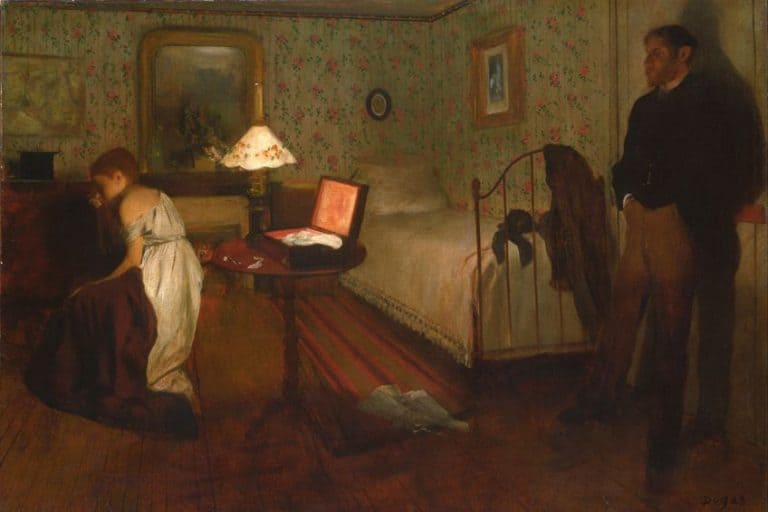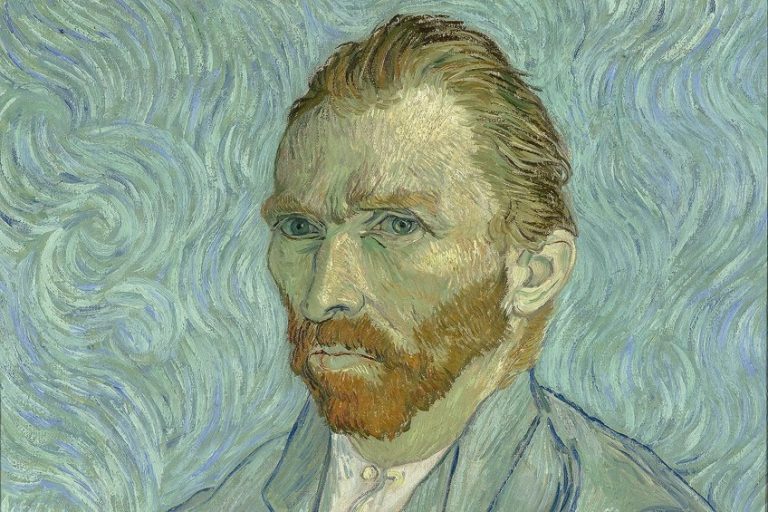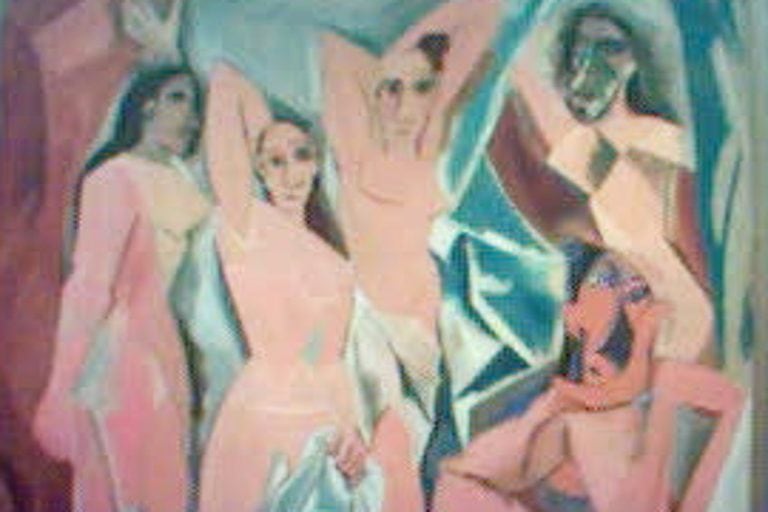“The Umbrellas” by Pierre-Auguste Renoir – A Visual Analysis
Pierre-Auguste Renoir’s famous umbrella painting, titled The Umbrellas (c. 1881 – 1886), is an example of the artist’s turn in style and technique. From Impressionism to Classicism and airy brushstrokes to more defined outlines, read further as this article explores this artwork and some of its key concepts.
Table of Contents
Artist Abstract: Who Was Pierre-Auguste Renoir?
Pierre-Auguste Renoir was a French painter from the city of Limoges in Haute-Vienne, France. He was born on February 25, 1841, and died on December 3, 1919. He grew up enjoying drawing and would visit the Louvre on frequent occasions. To earn money, he worked at a porcelain factory and painted decorations during his early years.
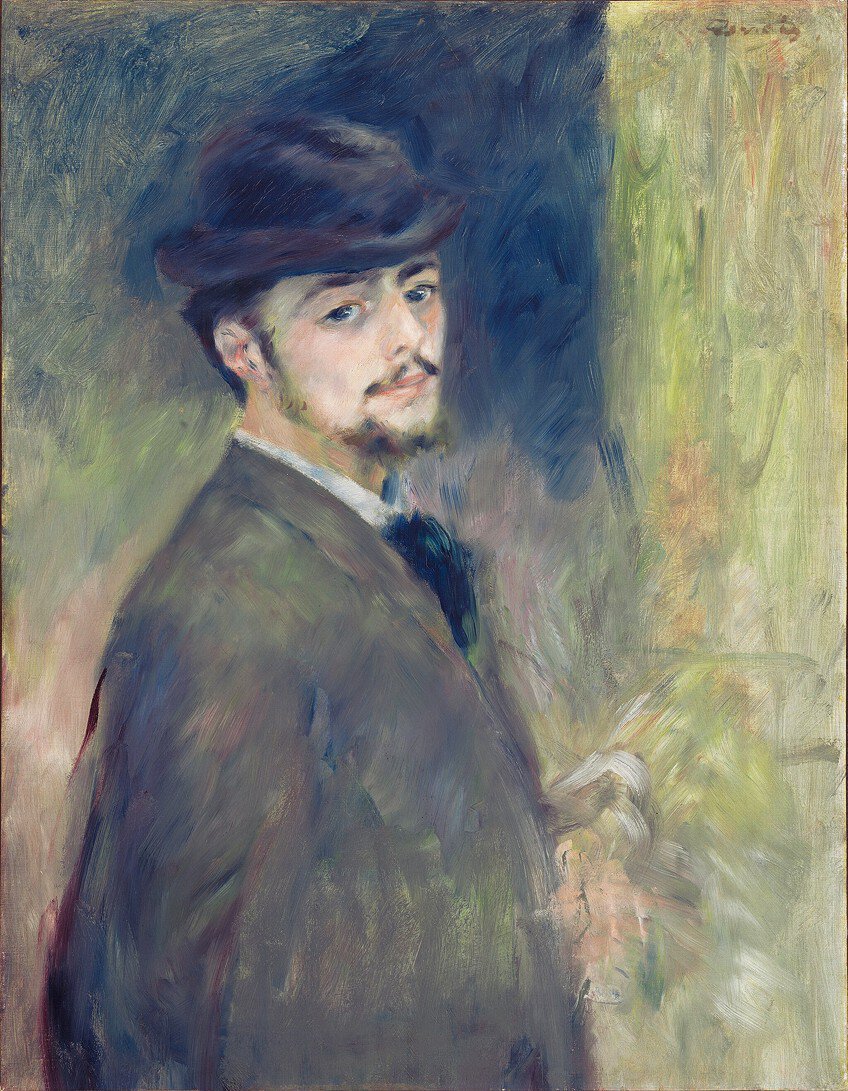
He eventually studied under Charles Gleyre in 1862 and was part of the initial exhibition of the Impressionists. His artistic career consisted of a variety of shifts in style, but he was known for his portrayal of everyday scenes of Parisian figures and modern lifestyles and fashions.
Examples of his artwork include The Swing (1876), Dance at Le Moulin de la Galette (1876), and Luncheon of the Boating Party (1881).
The Umbrellas (c. 1881 – 1886) by Pierre-Auguste Renoir in Context
| Artist | Pierre-Auguste Renoir (1841 – 1919) |
| Date Painted | c. 1880 – 1886 |
| Medium | Oil on canvas |
| Genre | Genre painting |
| Period/Movement | Impressionism |
| Dimensions (centimeters) | 180.3 x 114.9 |
| Series/Versions | N/A |
| Where Is It Housed? | National Gallery, London, United Kingdom (in partnership with Hugh Lane Gallery, Dublin, Ireland) |
| What It Is Worth | The exact price is uncertain |
In the article below you will read more about Pierre-Auguste Renoir’s famous umbrella painting, when it was painted, and how he painted it. A formal analysis will discuss the subject matter and elements of art.
Contextual Analysis: A Brief Socio-Historical Overview
The Umbrellas by Pierre-Auguste Renoir was one of the artist’s paintings that became a visual example of his changes in artistic style. It was done over several years, from Renoir’s Impressionist style to the Classical, the latter inspired by the French Neoclassicist Jean-Auguste-Dominique Ingres. Renoir was one of the artists who helped find the Impressionism art style during the 1860s. He painted alongside other artists like Claude Monet, Alfred Sisley, Édouard Manet, Berthe Morisot, Mary Cassatt, Camille Pissarro, and others.
During his Impressionist period, he painted landscapes and everyday subject matter of people in their everyday settings, notably of times like dances and lunches or people dressed in their fashionable attire.
Some of his primary figures included portraits of children and women in different settings. For example, a famous painting includes his Dance at the Moulin de la Galette (1876), which depicts a crowd of people in their modern-day attire socializing and having a grand time. Notice how Renoir depicted the dappled light reflected on some figures and the dance floor.

He was renowned for how he depicted color and light, and reflections on the subject matter. His brushwork was light and loose, which contributed to the airy effects of his paintings. He also painted in the en plein air style, which in French means “outdoors”. This was a characteristic of the Impressionist artists who painted subject matter outdoors.
While Impressionism was an important part of Renoir’s artistic oeuvre, he started to feel disconnected from it and pursued another stylistic approach, inspired by Classical art. He traveled to Italy during the early 1880s, which reportedly influenced this artistic style.
During his trip, he saw artworks by some of the biggest names in art history like Leonardo da Vinci and Raphael, among others. He is often quoted as describing an endpoint that he reached with Impressionism, and he realized he did not know how to paint or draw. His style became more structural in line and form, and he adopted a more defined approach.
Formal Analysis: A Brief Compositional Overview
The Renoir umbrella painting analysis below will consist of a visual description of the subject matter and a closer look at how the art elements like color, texture, line, shape, form, and space are utilized to create the overall composition.

Subject Matter: Visual Description
The Umbrellas by Pierre-Auguste Renoir is set in a Parisian street where throngs of people are walking in all directions. Most of the people are holding umbrellas shielding them from the cloudy and rainy weather. There are six figures in the foreground, clear in view. These figures are better understood when viewed as two groups, their clothing style and Renoir’s painting style, which corresponds to the years he completed them.
The right side of the composition depicts four main figures in the foreground, two women and two girls. The two younger girls are standing closer to the right edge, they are sisters reportedly with their mother.
The older of the two girls stands in profile and her back is cut off by the edge of the composition. Her head is tilted to the left side and her hat covers her eyes, only revealing the left side of her face. She is standing by the younger of the two with her left hand on her sister’s left shoulder as if to hold her close and protect her. The younger girl is looking at us, the viewers, and is standing more in a frontal position than her sister. She is holding a wooden hoop and stick, which was a popular toy and game during the Victorian era.

The woman standing next to the girls’ right (our left) appears to be looking downwards towards the girls and holding her umbrella over herself and the young woman standing next to her, whose face is partially visible and turned upwards as if she is looking towards the sky and rain. She is in the process of either opening or closing her own umbrella. The clothing of these four figures suggests the fashion style from 1881.
Standing on the left edge in the immediate foreground is a young woman who has been described as a milliner’s assistant or a modiste (a fashion dress or hatmaker). Interestingly, she was reportedly Suzanne Valadon who modeled for Renoir.
She is looking at us, the viewers, and is carrying a cane bandbox over her left forearm, which appears to be empty. Her right hand is holding onto her dress, pulling it up on the right side, as if not to get it wet from the water on the ground. She is also not holding an umbrella or wearing gloves. Her outfit is more reserved in its style than the other figures’ outfits to the right, which suggests that Renoir painted her during the later stages of the painting’s creation, which was around 1885, and aligned with the fashion of that time.

Visible behind the young woman’s right side (our left) is a gentleman holding an umbrella over his right shoulder. He is wearing a black top hat, gloves, a light brown, almost camel-colored jacket, and dark pants. He has been described as possibly offering his umbrella to the young woman. The background recedes into various figures all going about their way and the far distance. The upper part of the composition reveals part of the cloudy sky, the greenery of trees on the left, and the shape of the Parisian apartment buildings on the right.
Color
The color scheme for Renoir’s famous umbrella painting, The Umbrellas, appears earthy and consists mostly of various blues and grays with browns, greens, some reds, and whites. Some of the pigments that Renoir utilized were artificial ultramarine, cobalt blue, Naples yellow, zinc yellow, and red lake.
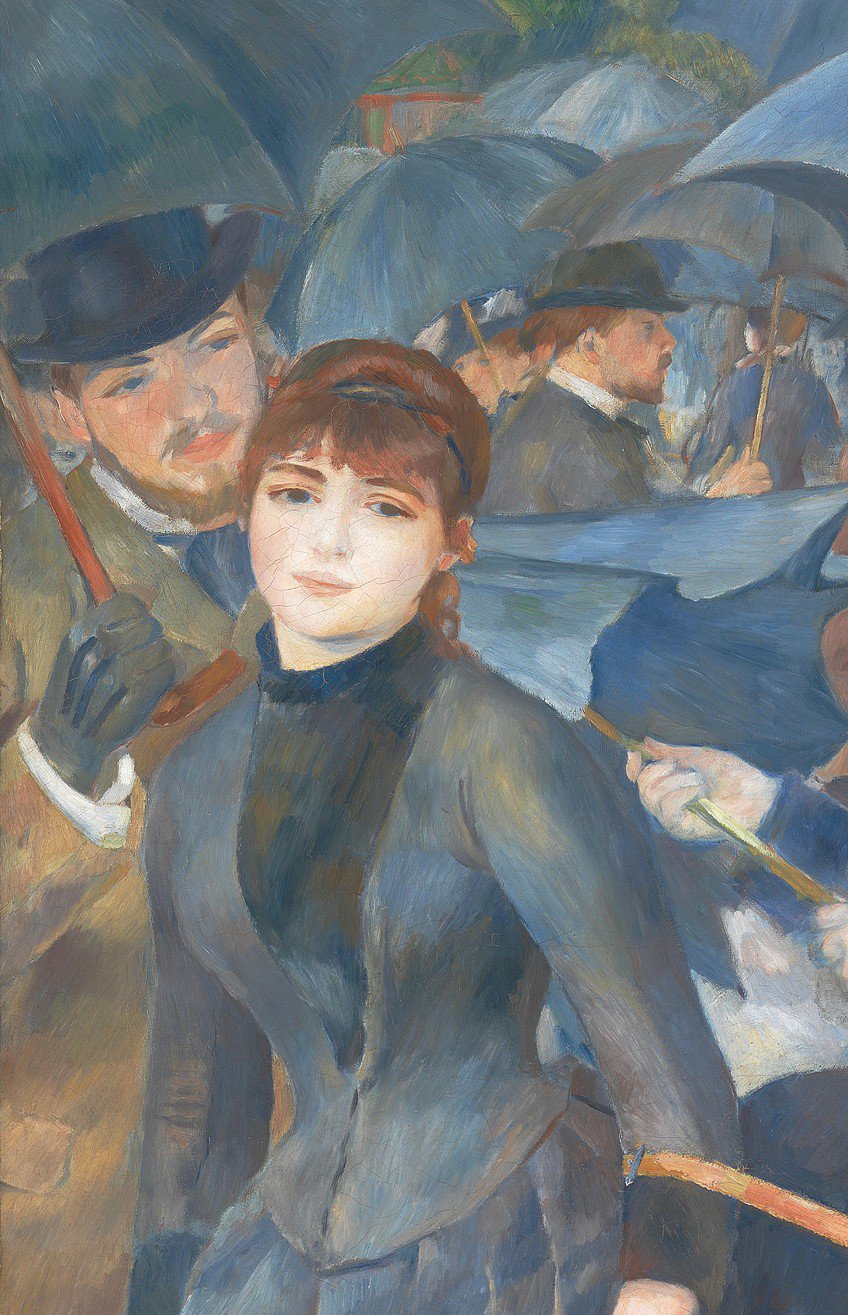
Texture
Renoir painted in two distinct styles, which is evident through his brushstrokes. The figures on the right have often been described as “feathery”, and the artist’s brushstrokes appear somewhat looser, softer, and less defined, which corresponds with his Impressionistic style of painting during that time.
Renoir’s brushstrokes appear more defined for the figure on the left, which indicates his shift in painting style from Impressionism to what was termed his “Ingres style” where he employed more classical painting techniques.

Line
There are a variety of straight, curved, and diagonal lines in The Umbrellas by Pierre-Auguste Renoir. Some of these lines are more fluid and naturalistic, otherwise termed organic, for example, the trees in the far distance or the looser brushstrokes of the figures’ clothing to the right. Some lines are also geometric, for example, the straight curves that delineate the domed shapes and segments of the umbrellas or the more defined lines of the folds on the dress of the young woman to the left.

Shape and Form
There are various organic (natural) and geometric shapes in The Umbrellas by Pierre-Auguste Renoir. The figures have naturalistic shapes and forms, which contrasts with the more geometric shapes of the umbrellas, the circular shape of the hoop, and the cubic shape of the bandbox.
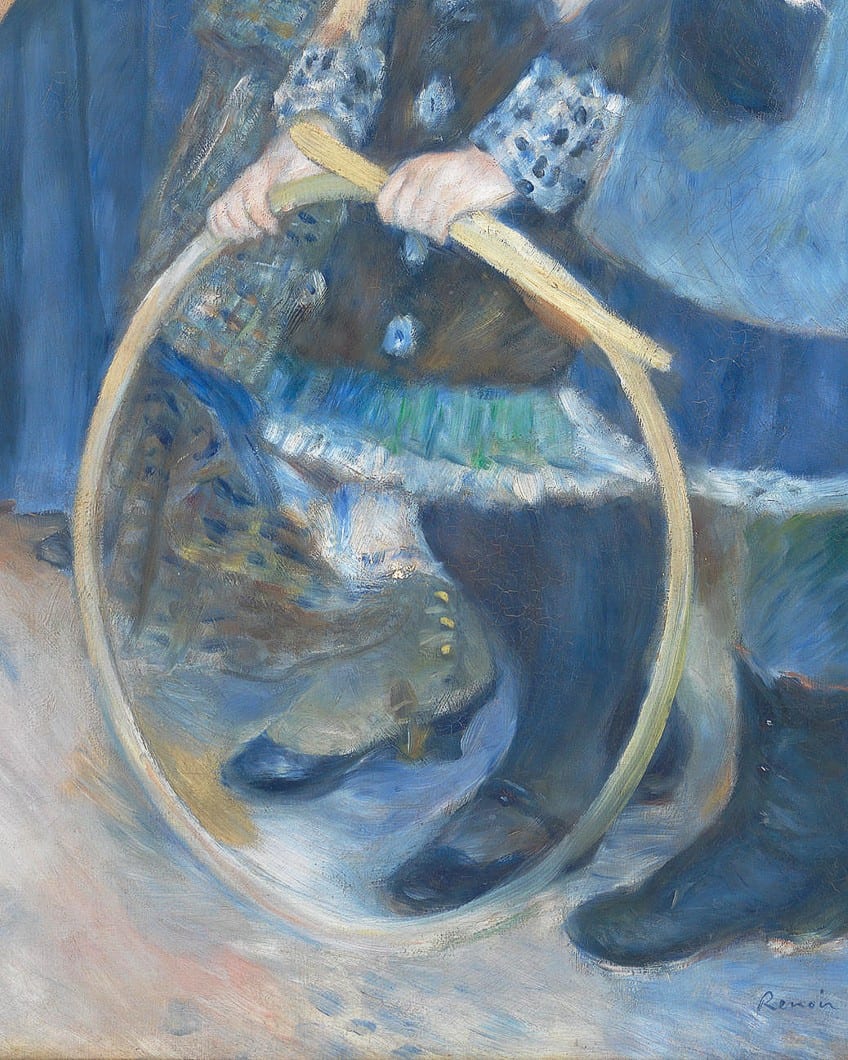
Space
Renoir filled the compositional space with figures in The Umbrellas painting, creating a sense of dynamism. Furthermore, there is a sense of depth created through various perspectival techniques, for example, the diminishing and blurring of the figures as they recede into the background compared to the more defined figures in the foreground.

A Two-in-One Renoir
While extensive studies have been made on The Umbrellas by Pierre-Auguste Renoir, this umbrella painting analysis briefly touched on a few of the important aspects of this beautifully executed Parisian street scene depicting the artist’s stylistic shifts over a period of five to six years.

Renoir started to move away from his Impressionistic style of painting and was influenced by the more classical techniques of artists like the French Neoclassicist Jean-Auguste-Dominique Ingres, and thus made changes to what he initially painted in The Umbrellas.
You might say that The Umbrellas is a stylistic two-in-one painting of a bustling street in Paris that Renoir utilized to demonstrate his stylistic evolution. It captures a moment where only two figures have seemingly stopped to look back at us, who are the viewers from a different time and place looking back at them.
Take a look at our The Umbrella painting webstory here!
Frequently Asked Questions
Who Created The Umbrellas Painting?
The French painter, Pierre-Auguste Renoir, painted the oil on canvas titled The Umbrellas (c. 1881 – 1886). The painting was executed in two phases, notably during 1881 and again during 1885/1886, which explains its stylistic differences.
Where Is The Umbrellas by Pierre-Auguste Renoir?
The oil on canvas, The Umbrellas (c. 1881 – 1886), by Pierre-Auguste Renoir is part of the Sir Hugh Lane Bequest. It is located at the National Gallery in London, the United Kingdom, but has also been on display at the Hugh Lane Gallery in Dublin due to the partnership between the two galleries.
What Style Was The Umbrellas by Pierre-Auguste Renoir Painted In?
The famous umbrella painting was known to be part of the end of Renoir’s Impressionistic style of painting, and part of a more formal style of painting that has often been termed his so-called Dry Period or Ingres Period, which was around 1883 to 1887.
Alicia du Plessis is a multidisciplinary writer. She completed her Bachelor of Arts degree, majoring in Art History and Classical Civilization, as well as two Honors, namely, in Art History and Education and Development, at the University of KwaZulu-Natal, South Africa. For her main Honors project in Art History, she explored perceptions of the San Bushmen’s identity and the concept of the “Other”. She has also looked at the use of photography in art and how it has been used to portray people’s lives.
Alicia’s other areas of interest in Art History include the process of writing about Art History and how to analyze paintings. Some of her favorite art movements include Impressionism and German Expressionism. She is yet to complete her Masters in Art History (she would like to do this abroad in Europe) having given it some time to first develop more professional experience with the interest to one day lecture it too.
Alicia has been working for artincontext.com since 2021 as an author and art history expert. She has specialized in painting analysis and is covering most of our painting analysis.
Learn more about Alicia du Plessis and the Art in Context Team.
Cite this Article
Alicia, du Plessis, ““The Umbrellas” by Pierre-Auguste Renoir – A Visual Analysis.” Art in Context. December 22, 2023. URL: https://artincontext.org/the-umbrellas-by-pierre-auguste-renoir/
du Plessis, A. (2023, 22 December). “The Umbrellas” by Pierre-Auguste Renoir – A Visual Analysis. Art in Context. https://artincontext.org/the-umbrellas-by-pierre-auguste-renoir/
du Plessis, Alicia. ““The Umbrellas” by Pierre-Auguste Renoir – A Visual Analysis.” Art in Context, December 22, 2023. https://artincontext.org/the-umbrellas-by-pierre-auguste-renoir/.




